Heavy audio presence: Audio-Technica takes the MotoGP challenge onboard at Jerez
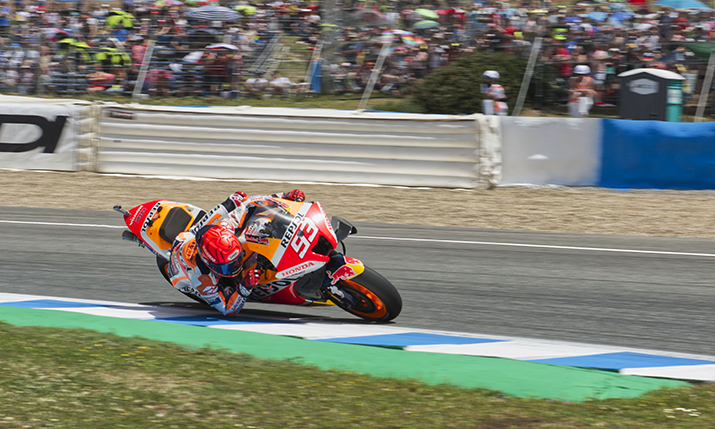
At MotoGP’s Jerez outing, Audio-Technica was on the case with a complex array of mics
I’m sitting in the Audio Control Room (ACR) in the Dorna Sports compound at the Circuito de Jerez-Angel Nieto in Andalusia, watching as the bikes of the MotoGP race around the multiview screens, and experiencing the thunder and zoom of their engines in 5.1 audio around the small mobile trailer.
In charge of this immersive audio landscape taking place on 1 May is Pep Mendoza, sound manager for host broadcaster Dorna Sports, who sits ready at the Lawo mc²56 mixing console, attentive to the requests coming through his Audio-Technica headphones from the race director in the International Programme Feed (IPF) gallery across the compound.
“You may think that if things are loud, it’s easy to capture. But with a high level of contamination from the environment, it’s difficult to focus on anything. You need to find microphones capable to work under the extremely high sound pressure levels (SPL) of the bikes”
The desk inputs, set for Audio Follow Video, move in time with the main feed; there would be no way anyone could handle the fast switching of the inputs from so many sources. Suddenly there is a crash, Mendoza reaches over and smoothly adjusts his faders, and the pebbly sound of the bike and (safe) rider skidding across the gravel on a corner fills the room.
This total immersion is aided by the clever placement of hundreds of microphones around the track and onboard the bikes, all supplied, like all the production headphones as well as the press conference audio system, by Audio-Technica. The transducer specialist has recently signed a second consecutive three-year relationship with Dorna to be the official Microphone Solutions Services Provider to MotoGP.
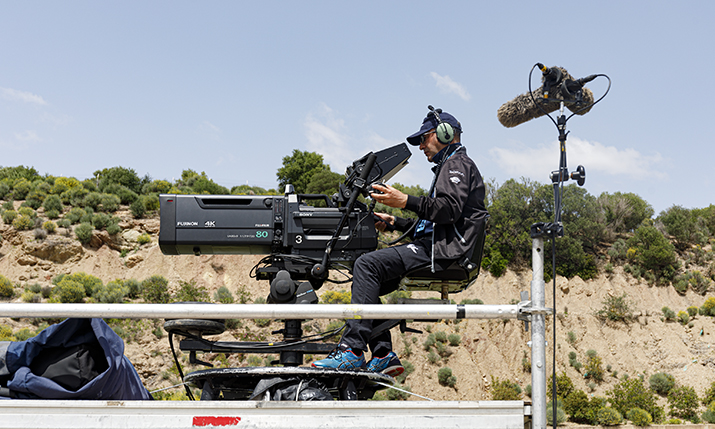
The R&D is all driven by Dorna for MotoGP. Dorna writes all the software, so they know what they needed in terms of workflow for their broadcasts
Getting specific with audio
Rodrigo Thomaz is the Audio-Technica Europe project manager for MotoGP. A sound solution fixer, he has an encyclopaedic knowledge of the Audio-Technica product range, which has proved invaluable when faced with the challenges Dorna and motorbike racing has been throwing at him since 2019.
Coming to MotoGP from music and other sports was a unique experience for Thomaz, even a shock. “The most obvious challenge is the sheer volume that is created by the bikes and the environment itself,” Thomaz tells us as that very noise envelops the paddock at Jerez. “You may think that if things are loud, it’s easy to capture. But with a high level of contamination from the environment, it’s difficult to focus on anything. You need to find microphones capable to work under the extremely high sound pressure levels (SPL) of the bikes, but at the same time, perform in delivering high quality and detail.
“We had to take time to decipher it,” he adds. “We created solutions for each portion of track, rather than approach MotoGP as one thing.”
It is not a small task; on the weekend we were at Jerez, there were 22 track feed cameras alone, including a jimmy jib, ground cams, bridge cams and several fixed and tripod positions.
The set up used by Dorna Broadcast’s previous microphone supplier was ‘a lexicon of brands’ says Thomaz, including mics from Audio-Technica. “We replaced those, and of course every other brand as well.”
The new microphone solutions Thomaz specified were all existing Audio-Technica models or could be modified when required.
“At Audio-Technica, we have a history of creating microphones that have high SPL tolerance anyway,” Thomaz explains. “We always strive for a high level of detail and clarity, especially when you’re talking about spoken voice, for a boundary mic, a gooseneck, a commentator mic, a handheld mic, and so on. But even our shotguns were designed with that in mind.”
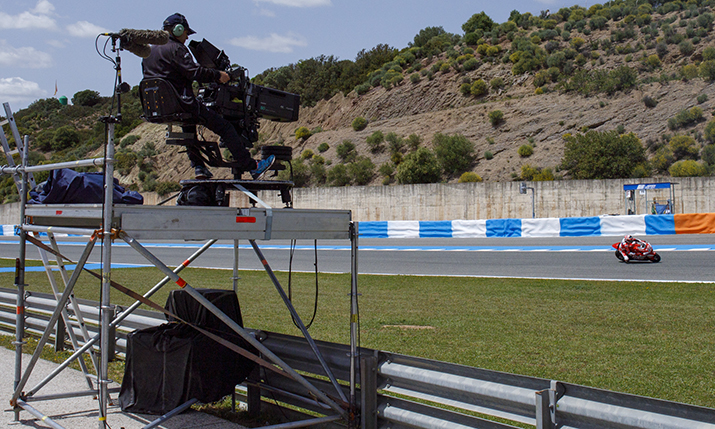
MotoGp at Jerez, cameras and mics at the ready
Chasing onboard sound
MotoGP has the highest number of cameras in a single sports broadcast, mainly because there are four onboard cameras for each bike. “If you have a camera there is a need to have audio,” says Thomaz. “We are not talking about a static mic, these are objects moving at 350km per hour.”
SVG has previously covered how Audio-Technica collaborates with Dorna to test prototype kit, such as the BP3600/ 8.0 Microphone Concept, but it has also been working on a modified version of one of its lapel mics, the BP899, specifically for MotoGP bikes.
“Dorna does all the hard work,” says Audio-Technica Europe’s CEO Robert Morgan-Males. “They’ve had years of experience of sending video and audio separately from a bike. The R&D is all driven by Dorna, they write all the software, so they knew what they needed in terms of workflow. In terms of the microphones, they knew how it’s going to have to fit, they knew where it needed to physically be, they knew what the environment and temperatures were – the bikes get incredibly hot around those engines – it was up to us to design a microphone solution that will work within those parameters. Environmentally our mics stand up to a lot already. With some modifications, we were able to get into that testing stage quite quickly.”
“We worked on that for two years with Audio-Technica,” adds Mendoza. “They created special little lavalier microphones for us. Right now, we have two on the bike.
“It’s not like a [racing car] where they have a lot of space and the driver is in a fixed position,” he continues. “The microphones and transmitters or receivers in the bike [have to be smaller] and the rider is moving all the time.”
Microphones and components also must survive the constant stripping down of the bikes by their team mechanics in the pit lane ‘boxes’.
As the organiser of the Championship, Dorna has the crucial ability to persuade the bike teams to let it use and test broadcasting technologies on the bike. It is no small ask.
“The weight on the bike is critical, especially when you’re in the MotoGP class; an extra gramme is going to make you think I’ve got a disadvantage against your competitor,” says Morgan-Males. “We must provide an equal solution for everyone, but the hard work is done there by Dorna. In fact, the hardest work was done many years ago when they first persuaded the teams to have a camera on board.”
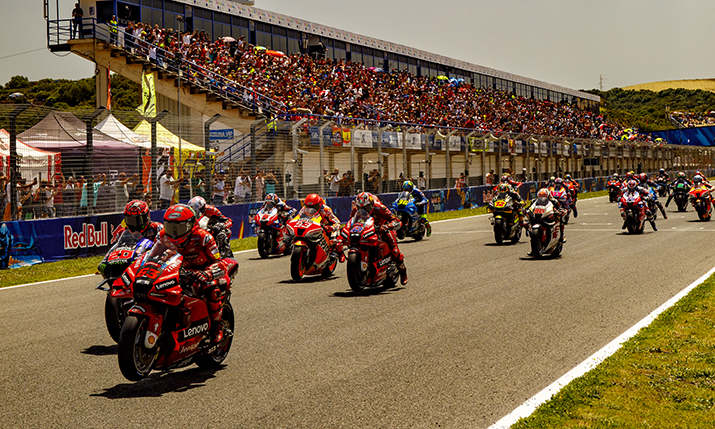
As the organiser of the Championship, Dorna has to persuade the teams and riders to take new cameras and mics onboard, which is no easy task
Micing the track
On the track at Jerez for the last race weekend there were three of the new Audio-Technica BP3600 microphones. This is a highly versatile product, according to Thomaz, able to capture high-end detail, the different crowd noise and atmospheres at the various tracks, as well as tolerate working with high sound pressure levels. A high number of the BP28 large-diaphragm shotgun mics are mounted on cameras very close to corners or situated on the main straights. “The high SPL is the first thing you have to worry about, but we want to make sure we also capture the extreme low end,” says Thomaz. “As the bikes reduce speed, we gain low-end but also you have explosions from the exhaust. So we have a microphone which has a lot of headroom to be able to cope with those very fast transients, but also delivers the low end that comes behind that.”
The BP28s are twin mounted in a particular configuration, at 110° or sometimes 90° angles, depending on the track.
Earlier in the ACR, Mendoza had shown me one such position on the Jerez camera plan, a corner out on one of the ‘wings’ of the track, to capture ‘the flash’, when the bike is coming from left to right,
“You see the bikes pass so fast in front of the camera,” he says. “We put our stereo microphones just in front of it, with the shotguns at 90°, so you can hear the bike first from the right side and it disappears off the left side. That richness is important for us.”
It’s the same aim with the overhead bridge cameras, which are positioned behind the bridge. “We put a microphone in front and another one to the rear,” says Mendoza. “You have the flash, and in terms of 5.1 or immersive, the sound comes from the front to the rear.”
The cameras which are positioned further from the track with longer zoom lenses are matched with the longer BP28L version. “That allows you to focus more on the portion of the track or each bike, depending on where you are zooming in, and at the same time rejecting the sound behind,” Thomaz says. “We have on average 120,000 people, so it gets very loud on race day.”
The long straights, particularly the starting grid are covered by the BP4025, a stereo mic with highly detailed sound and high SPL. But for MotoGP, Dorna has paired this with the BP40, the company’s largest dynamic diaphragm microphone, normally used for broadcasts and voiceovers, but also has a high SPL tolerance. “They put on a filter so only the low-end sound is processed in this microphone, leaving the BP4025 to concentrate on low-mids, mids and high frequencies. Especially at the start, when 20 bikes are roaring together, it gets very loud. It’s too loud for human hearing. We need a mic that can go beyond that so that when the viewer is at home and has a surround system, we can put that low end back into the listening environment without distorting everything.”
Dorna uses a lot of interesting camera angles, deploying jibs to get both really low and also overhead shots. These are matched by the BP4029, a very short stereo shotgun mic. “It gives a very nice spread from left to right but again it must be able to tolerate the highest SPL,” says Thomaz. “We also use them on the shoulder-mounted ENG cameras. As the operators navigate inside the boxes; they need a stereo image to match a wide-angle lens.”
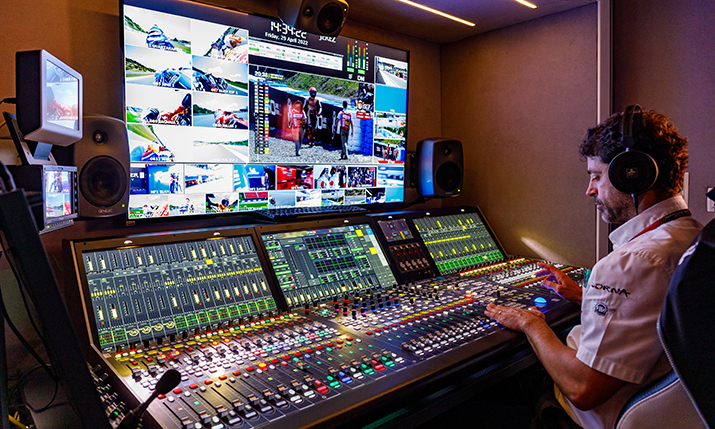
Listening to the roar of the bikes with Audio-Technica at MotoGP in Jerez
Some of these boxes are also wired for sound, in that a few have a U851R boundary microphone positioned high on the wall. Again it’s a versatile mic with high SPL, which can capture the sound of each box at the pit lane, as the bikes come and go out.
“When there is a problem and the bikes come into the box, the viewers get to see all the action, but previously they couldn’t hear what was going on,” says Thomaz. “But now you can: they’re filling up the tank, you can hear the tools, you can hear them working on the bike, the general chatter.”
Just as with the video coverage of the boxes, the teams all trust Dorna not to broadcast any key conversations or reveal trade secrets.
“The pit lane is the heart and soul of MotoGP, it’s where all the action happens,” says Thomaz. “Now you can hear and feel what they feel and hear as if you were there.”
Audio-Technica covers comms as well. “The BPHS2 headset is widely used,” says Thomaz. “We have a Dante-enabled wireless system for the gooseneck mics in the conference room, ENG camera microphones and wireless mics for the roving reporters, while the broadcast set truck uses a completely different set of microphones for interviews between races; everything outside and inside the track is kitted out with Audio-Technica components”
Heavy audio presence
“You might have sixty-odd mics on the track, but when you start counting all the microphones in and off the track, and the onboard mics on the bikes as well, it will be more than 300 channels that Dorna has to manage live on each race,” says Thomaz.
All these various live sources are mixed locally before everything ends up in the ACR where Pep Mendoza applies his final touches.
“Audio is so important for us on MotoGP,” Mendoza tells me earlier that day. “We have a lot of audio sources that are very interesting for MotoGP fans. There’s the bike, which has a lot of sounds, wheels, engine, crashes on the track; then there are sounds from the riders too, like exclamations, and cries. There’s talking inside the boxes, the noise of the tools; yes, audio is very important for us.”
The immersion also comes from the sound of the crowd in the stands, a facet of the atmosphere that Mendoza is keen to include in the mix, no matter that it makes his job harder. 7.1 height channels will allow Dorna to place you even closer into the action.
“You see the bike in front of you, that will be from left to right. But with the ceiling speakers, it’s like you’re in a stadium, you can hear all the other things. It’s important for us that the home experience is exactly like you’re at MotoGP.”
Thomaz observes that there is something new from Dorna at every race he attends. “They keep finding different ways to use the microphones,” he says. “They are improving themselves all the time and luckily for us the microphones that we provide allow them to do that.”
